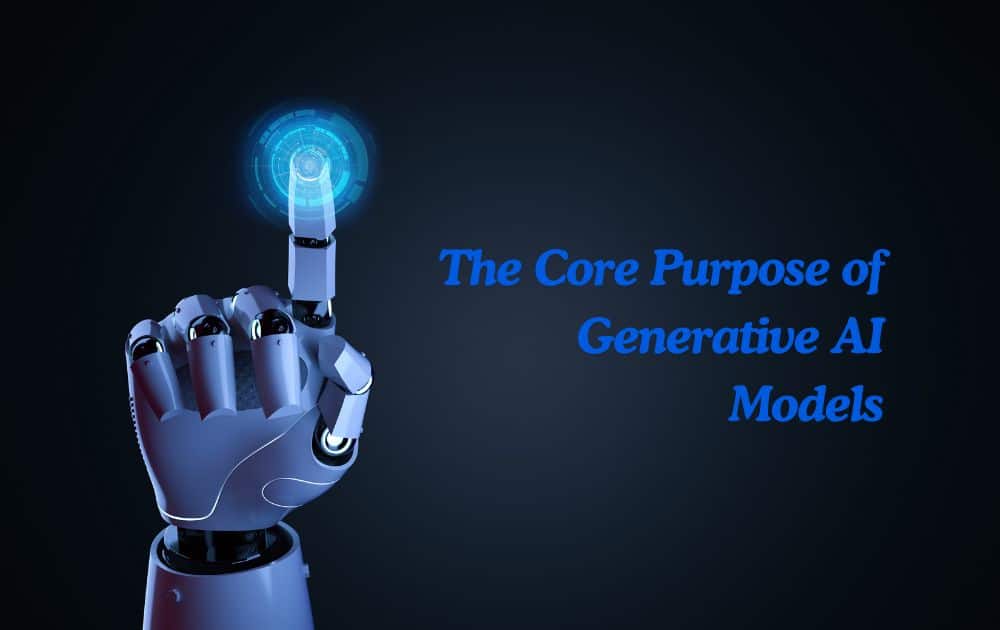What if computers could create new songs, stories, or even pictures all on their own? This is exactly what generative AI models do—they use artificial intelligence to make new and unique content.
Generative AI is important because it helps us come up with creative ideas, solve problems, and make things like video games and movies more exciting.
In this blog, we’ll explore how generative AI works, its real-world uses, and why understanding it is important for the future of technology and creativity.
Table of Contents
Understanding Generative AI
What Is Generative AI?
Generative AI is a type of artificial intelligence that can create new content from scratch. Unlike other types of AI that might only follow specific instructions, generative AI learns from existing data and uses that knowledge to generate something new. For example, if you feed a generative AI model lots of images of cats, it can learn to create new pictures of cats that look like they were drawn by an artist or taken by a photographer, even though they’ve never existed before.
How Does Generative AI Work?
Generative AI works by using complex algorithms that learn patterns in data. A common approach is using neural networks, which are computer systems modeled after the human brain. These networks can process vast amounts of data and learn to create new outputs that mimic the input data.
One popular type of generative AI model is the Generative Adversarial Network (GAN). GANs work by having two parts: a generator and a discriminator. The generator creates new content, while the discriminator checks how close the generated content is to the real thing. Over time, the generator gets better at making realistic content because it’s constantly being trained to fool the discriminator.
The Core Goal of Generative AI: Creating New Content
Why Do We Use Generative AI?
The main purpose of generative AI is to create new content that is useful or entertaining. This ability to generate new things is what sets generative AI apart from other types of AI.
For instance, think about video games. Developers can use generative AI to create entire landscapes, characters, and even storylines, making games more dynamic and interesting.
Similarly, in music, generative AI can compose new songs that sound like they were made by your favorite artist. The core goal is to push the boundaries of creativity by using AI to assist in the creation of something unique.
Examples of Content Created by Generative AI
Images and Art:
Generative AI can create stunning pieces of art or realistic images that don’t exist in the real world. AI artists can use these tools to come up with new styles or to enhance their creativity.
Music:
AI can compose music in various genres, allowing musicians to explore new sounds or even generate background scores for movies and video games.
Writing:
AI models can write stories, articles, and even poetry. This is particularly useful for creating content quickly or for helping writers brainstorm new ideas.
Virtual Worlds:
In video games and virtual reality, AI can generate entire worlds, complete with landscapes, weather, and even non-playable characters (NPCs) that interact with players.
Real-World Applications of Generative AI
How Is Generative AI Used in Everyday Life?
Generative AI is not just a concept from science fiction; it’s being used in many ways that affect our daily lives. Here are a few examples of where you might encounter generative AI:
1. Entertainment Industry
Movies and Animation:
Generative AI is used to create special effects, animate characters, and even develop entire scenes in movies. It can also help filmmakers by creating realistic environments without the need for physical sets.
Video Games:
AI-generated worlds, characters, and stories make video games more engaging. Games like “Minecraft” use generative AI to create vast, unique landscapes for players to explore.
2. Art and Design
Fashion:
Designers use generative AI to create new clothing patterns and designs. This helps in producing innovative fashion trends that are both unique and practical.
Graphic Design:
AI tools can assist graphic designers by generating logos, posters, and other visual content based on simple inputs.
3. Education
Learning Tools:
Generative AI can create personalized learning materials for students, such as customized quizzes, exercises, and even explanations that adapt to a student’s learning pace.
Content Creation:
Teachers can use generative AI to produce engaging content for lessons, such as interactive stories or virtual environments that make learning more fun.
4. Healthcare
Drug Discovery:
Generative AI helps scientists by creating new molecules that could be used in medicine, speeding up the process of drug discovery.
Medical Imaging:
AI models can generate detailed images from scans, helping doctors diagnose diseases more accurately.
5. Marketing and Advertising
Personalized Campaigns:
Generative AI can create personalized marketing content, such as tailored advertisements, emails, and social media posts. This helps businesses reach their audience more effectively by delivering content that resonates with individual preferences.
Content Generation:
AI can generate product descriptions, blog posts, and promotional materials, saving time for marketers and ensuring consistent messaging across different platforms.
6. Music and Audio Production
Music Composition:
Generative AI can compose new music tracks in various genres, assisting musicians in exploring new sounds or creating background scores for films and games.
Sound Design:
AI can generate sound effects and audio environments, helping sound designers create immersive experiences in media like movies, games, and virtual reality.
7. Customer Service
Chatbots and Virtual Assistants:
Generative AI powers chatbots that can generate natural language responses to customer inquiries, providing quick and efficient support. These AI assistants can handle everything from answering FAQs to helping with more complex issues.
Personalized Recommendations:
AI can generate personalized product recommendations based on customer preferences and behavior, enhancing the shopping experience.
8. Architecture and Urban Planning
Design Prototyping:
Generative AI can assist architects by creating design prototypes for buildings and urban spaces. This allows architects to explore multiple design options quickly and efficiently.
Smart City Planning:
AI can generate models for optimizing city layouts, traffic flow, and resource management, contributing to the development of smart, sustainable cities.
9. Writing and Content Creation
Storytelling:
Generative AI can write stories, scripts, and even poetry, helping writers brainstorm ideas or produce content more rapidly. It can also generate dialogue for video games or create entire narratives for virtual experiences.
Editing and Proofreading:
AI tools can assist in editing and improving the quality of written content, ensuring that it is clear, concise, and error-free.
These additional applications demonstrate the broad impact of generative AI across various fields, from creative industries to practical, everyday tasks, showing how AI is increasingly becoming an integral part of our lives.
Generative AI vs. Traditional AI
What’s the Difference Between Generative AI and Traditional AI?
Generative AI is different from traditional AI in a few key ways. Traditional AI is usually focused on tasks like analyzing data, making decisions, or following instructions. It’s often rule-based, meaning it follows a set of guidelines to perform its tasks.
On the other hand, generative AI is more creative. It’s designed to produce new content rather than just following instructions. Traditional AI might be used to recognize patterns in data, like sorting emails into spam and non-spam.
Generative AI, however, might be used to create a new email template based on the ones it has seen before.
Why Does This Difference Matter?
Understanding this difference is important because it highlights the unique capabilities of generative AI.
While traditional AI is excellent at performing repetitive tasks, generative AI is powerful in creative fields where innovation and new ideas are key. This makes generative AI a valuable tool in industries like entertainment, design, and marketing.
The Importance of Responsible AI Use
Why Do We Need to Use AI Responsibly?
As powerful as generative AI is, it’s important to use it responsibly. Because AI can create new content, there’s a risk that it could be used to create harmful or misleading information, like deepfake videos or fake news. This is why developers and users must ensure that AI is used ethically.
How Can We Promote Responsible AI Use?
Transparency:
It’s important for AI developers to be transparent about how their models work and what they’re used for. This helps users understand the technology and trust the content it produces.
Bias Awareness:
AI models learn from data, which means they can pick up biases present in that data. Developers should work to minimize these biases to ensure fair and accurate AI outputs.
Ethical Guidelines:
Organizations and individuals should follow ethical guidelines when using AI, ensuring that it’s used for good purposes and not to harm or deceive others.
Conclusion
Generative AI models are an exciting and rapidly growing field within artificial intelligence. Their core purpose is to create new content, whether it’s art, music, writing, or even entire virtual worlds.
These models have a wide range of applications, from entertainment to healthcare, and their creative capabilities set them apart from traditional AI.
As we continue to develop and use generative AI, it’s crucial to understand how it works and why responsible use is important. By doing so, we can harness the power of generative AI to improve our lives while ensuring that it’s used in a way that benefits everyone.
By exploring the core goals, real-world applications, and related topics like the differences between generative and traditional AI and the importance of ethical AI use, we gain a better understanding of this fascinating technology and its potential impact on the future.



